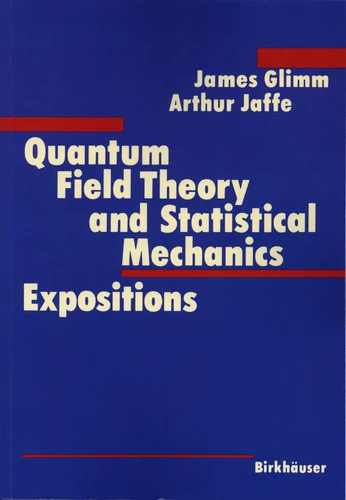Quantum Field Theory and Statistical Mechanics. Expositions
Par : ,Formats :
- Paiement en ligne :
- Livraison à domicile ou en point Mondial Relay indisponible
- Retrait Click and Collect en magasin gratuit
- Réservation en ligne avec paiement en magasin :
- Indisponible pour réserver et payer en magasin
- Nombre de pages418
- PrésentationBroché
- FormatGrand Format
- Poids0.825 kg
- Dimensions17,8 cm × 25,5 cm × 2,3 cm
- ISBN0-8176-3275-1
- EAN9780817632755
- Date de parution01/01/1985
- ÉditeurBirkhäuser
Résumé
Quantum fields were proposed in the late 1920's as the natural framework which combines quantum theory and - relativity. They have survived ever since. This collection of expository articles clearly and comprehensively presents the developments over the past 20 years. Written by two of the foremost researchers in the field, these articles contain basic material that has not been widely accessible before.
The lecture notes on `Field Theory and Boson Quantum Field Models' develop the basic theme of constructive quantum field theory. The expositions published here combine two alternative approaches to constructive quantum field theory : the Hamiltonian approach based on Hilbert space methods, and the Euclidean approach based on functional integrals and probability theory. The idea of phase cell localization is developed, which leads to understanding constructive quantum field theory.
Technical tools such as cluster expansion, which can be used in studying large-distance effects in correlations (infrared-phenomena), as well as in the analysis of certain short-distance questions of local regularity (ultraviolet phenomena), are presented and discussed in detail. The combination of exposition of basic ideas and mathematical concepts with physical interpretation that leads to laboratory studies provided by mathematically exact quantum field models makes these papers invaluable to those working in the field, particularly graduate students embarking on new areas of research.
The lecture notes on `Field Theory and Boson Quantum Field Models' develop the basic theme of constructive quantum field theory. The expositions published here combine two alternative approaches to constructive quantum field theory : the Hamiltonian approach based on Hilbert space methods, and the Euclidean approach based on functional integrals and probability theory. The idea of phase cell localization is developed, which leads to understanding constructive quantum field theory.
Technical tools such as cluster expansion, which can be used in studying large-distance effects in correlations (infrared-phenomena), as well as in the analysis of certain short-distance questions of local regularity (ultraviolet phenomena), are presented and discussed in detail. The combination of exposition of basic ideas and mathematical concepts with physical interpretation that leads to laboratory studies provided by mathematically exact quantum field models makes these papers invaluable to those working in the field, particularly graduate students embarking on new areas of research.
Quantum fields were proposed in the late 1920's as the natural framework which combines quantum theory and - relativity. They have survived ever since. This collection of expository articles clearly and comprehensively presents the developments over the past 20 years. Written by two of the foremost researchers in the field, these articles contain basic material that has not been widely accessible before.
The lecture notes on `Field Theory and Boson Quantum Field Models' develop the basic theme of constructive quantum field theory. The expositions published here combine two alternative approaches to constructive quantum field theory : the Hamiltonian approach based on Hilbert space methods, and the Euclidean approach based on functional integrals and probability theory. The idea of phase cell localization is developed, which leads to understanding constructive quantum field theory.
Technical tools such as cluster expansion, which can be used in studying large-distance effects in correlations (infrared-phenomena), as well as in the analysis of certain short-distance questions of local regularity (ultraviolet phenomena), are presented and discussed in detail. The combination of exposition of basic ideas and mathematical concepts with physical interpretation that leads to laboratory studies provided by mathematically exact quantum field models makes these papers invaluable to those working in the field, particularly graduate students embarking on new areas of research.
The lecture notes on `Field Theory and Boson Quantum Field Models' develop the basic theme of constructive quantum field theory. The expositions published here combine two alternative approaches to constructive quantum field theory : the Hamiltonian approach based on Hilbert space methods, and the Euclidean approach based on functional integrals and probability theory. The idea of phase cell localization is developed, which leads to understanding constructive quantum field theory.
Technical tools such as cluster expansion, which can be used in studying large-distance effects in correlations (infrared-phenomena), as well as in the analysis of certain short-distance questions of local regularity (ultraviolet phenomena), are presented and discussed in detail. The combination of exposition of basic ideas and mathematical concepts with physical interpretation that leads to laboratory studies provided by mathematically exact quantum field models makes these papers invaluable to those working in the field, particularly graduate students embarking on new areas of research.


